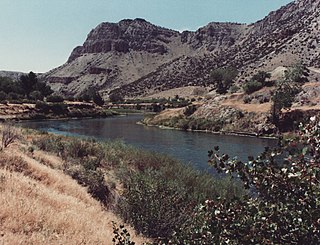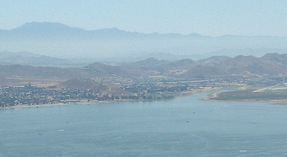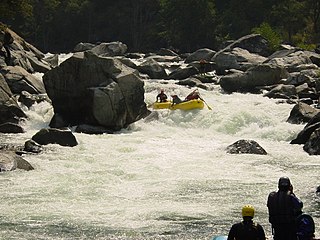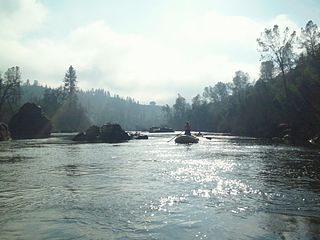| South Fork Stanislaus River | |
| Country | United States |
|---|---|
| State | California |
| Source | Sierra Nevada |
| - location | Stanislaus National Forest |
| - elevation | 8,642 ft (2,634 m) |
| - coordinates | 38°13′29″N119°49′05″W / 38.22472°N 119.81806°W [1] |
| Mouth | Stanislaus River |
| - location | New Melones Lake |
| - elevation | 1,050 ft (320 m) |
| - coordinates | 38°04′26″N120°25′24″W / 38.07389°N 120.42333°W Coordinates: 38°04′26″N120°25′24″W / 38.07389°N 120.42333°W [1] |
| Length | 48.5 mi (78 km) [2] |
| Discharge | for near Long Barn |
| - average | 85.1 cu ft/s (2 m3/s) [3] |
| - max | 12,900 cu ft/s (365 m3/s) |
| - min | 0 cu ft/s (0 m3/s) |
Map of the Stanislaus River watershed, showing the South Fork | |
The South Fork Stanislaus River is a major tributary of the Stanislaus River in Tuolumne County, California. The river flows for 48.5 miles (78.1 km) [2] through rugged alpine and foothill areas of the Sierra Nevada.

The Stanislaus River is a tributary of the San Joaquin River in north-central California in the United States. The main stem of the river is 96 miles (154 km) long, and measured to its furthest headwaters it is about 150 miles (240 km) long. Originating as three forks in the high Sierra Nevada, the river flows generally southwest through the agricultural San Joaquin Valley to join the San Joaquin south of Manteca, draining parts of five California counties. The Stanislaus is known for its swift rapids and scenic canyons in the upper reaches, and is heavily used for irrigation, hydroelectricity and domestic water supply.

Tuolumne County, officially the County of Tuolumne, is a county in the U.S. state of California. As of the 2010 census, the population was 54,179. The county seat and only incorporated city is Sonora.
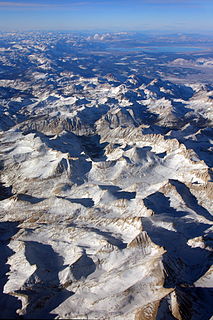
The Sierra Nevada is a mountain range in the Western United States, between the Central Valley of California and the Great Basin. The vast majority of the range lies in the state of California, although the Carson Range spur lies primarily in Nevada. The Sierra Nevada is part of the American Cordillera, a chain of mountain ranges that consists of an almost continuous sequence of such ranges that form the western "backbone" of North America, Central America, South America and Antarctica.
The river begins in Hay Meadow in the Emigrant Wilderness of the Stanislaus National Forest. It flows generally southwest, past Pinecrest, Cold Springs and Long Barn, then descends west through a canyon to the New Melones Lake reservoir where it meets the Stanislaus River. [4]
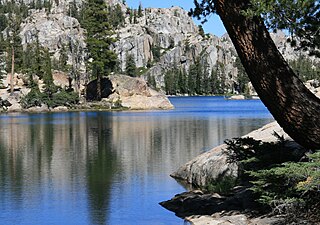
The Emigrant Wilderness of Stanislaus National Forest is a wilderness area in the Sierra Nevada. It is bordered by Yosemite National Park on the south, the Toiyabe National Forest and the Hoover Wilderness on the east, and State Route 108 over Sonora Pass on the north. It is an elongated area that extends northeast about 25 miles (40 km) in length and up to 15 miles (24 km) in width. Watersheds drain to the Stanislaus and Tuolumne Rivers. This area is entirely within Tuolumne County, California and is approximately 140 miles (230 km) east of San Francisco, California and 50 miles (80 km) south of Lake Tahoe.

Stanislaus National Forest is a United States national forest which manages 898,099 acres of land in four counties in the Sierra Nevada in Northern California. It was established on February 22, 1897, making it one of the oldest national forests. It was named after the Stanislaus River.

Pinecrest is an unincorporated community in Tuolumne County, California, United States. Pinecrest is located near Pinecrest Lake northwest of Mi-Wuk Village. Pinecrest Lake sits in what was once a meadow surrounded by granite outcroppings. Originally, Pinecrest Lake was called Strawberry Flat because of the wild strawberries that once grew there. In the 1960s the name was officially changed to Pinecrest. The campground adjacent to the lake is under the white fir, cedar, and sugar pine trees.
There are two dams on the South Fork: Strawberry Dam, which forms Pinecrest Lake, and Lyons Dam, impounding Lyons Reservoir, which provides municipal water supply to the Twain Harte area. Strawberry Dam is part of the Spring-Gap Stanislaus Hydroelectric Project, which uses water from the South Fork and Middle Forks of the Stanislaus River to generate power. [5]
Strawberry Dam, also known as Main Strawberry Dam, is a dam in Tuolumne County, California.
Lyons Dam is a dam in Tuolumne County, California.

Twain Harte is a census-designated place (CDP) in Tuolumne County, California, United States. The population was 2,226 at the 2010 census, down from 2,586 at the 2000 census. Its name is derived from the last names of two famous authors who lived in California, Mark Twain and Bret Harte.


